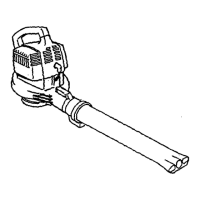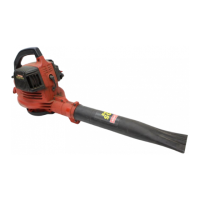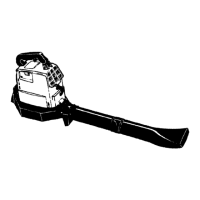Do you have a question about the Craftsman 358.797170 and is the answer not in the manual?
Details the terms and conditions of the two-year warranty for the Craftsman gas blower.
Emphasizes reading and understanding the manual and all warnings before operating.
Advises on protective gear, preparation, and avoiding hazards for safe operation.
Precautions for handling flammable fuel safely, including mixing, storage, and spill prevention.
Guidelines for operating the unit safely, avoiding dangerous environments, and proper use.
Recommendations for maintaining the unit's condition and using approved parts.
Advice on storing the unit and fuel safely in a ventilated area, out of reach of children.
Notices regarding prolonged use effects and cold weather health impacts.
Specific requirements for users in certain geographic areas regarding spark arresting screens.
Lists all items included in the product packaging to ensure completeness.
Instructions for attaching the blower tube to the unit securely.
Steps to assemble the vacuum bag and attach it to the blower.
Instructions for connecting the lower and upper vacuum tubes.
How to switch the unit from vacuum mode to blower mode.
Guide for adjusting the shoulder strap for optimal comfort during vacuum use.
Familiarization with unit controls, adjustments, and safety rules before use.
How to use the throttle lever for engine speed control and stopping.
How the primer button aids in starting the engine by supplying fuel.
General advice for efficient and safe unit operation, including noise reduction.
How the choke lever controls fuel/air mixture for cold engine starts.
Correct stance and handling for blower and vacuum use, keeping muffler away from body.
Crucial warning about reading fuel information and understanding safety rules.
Instructions on fuel mixture ratio, safe fueling procedures, and oil recommendations.
Important considerations for storing fuel, avoiding gasohol issues, and using stabilizers.
How to hold the unit correctly for starting, ensuring safety.
Detailed step-by-step guide for starting the engine from a cold state.
How to safely shut down the engine using the throttle lever.
Procedure for starting the engine when it is already warm.
Steps to take to start the engine if it becomes flooded.
Outlines owner's duties for performing maintenance and retaining records for warranty.
Schedule of regular maintenance tasks and their recommended frequencies.
Instructions to inspect the unit for loose screws, nuts, and bolts.
Identifying parts that may need inspection or replacement due to wear or damage.
Overall advice on maintaining the unit to ensure proper function and warranty validity.
Step-by-step guide to clean the air filter for optimal engine performance.
Instructions for replacing the spark plug for better starting and running.
Procedure for safely removing and installing a new fuel filter.
Instructions to ensure muffler mounting screws are secure annually.
Information on carburetor control and throttle settings for engine speed.
Preparing the unit for storage at the end of the season or for extended periods.
Guidance on fuel system preparation, including fuel stabilizer use.
Steps to prepare the engine for storage, including oiling and spark plug replacement.
Advice regarding fuel storage duration and gasoline can maintenance.
Outlines owner's duties for performing maintenance and presenting the unit for service.
Specifies which parts and services are covered under the emissions warranty.
Lists exclusions from warranty coverage due to abuse, neglect, or improper maintenance.
Steps to follow when initiating a warranty claim and contacting service centers.
Owner's responsibility for performing all required maintenance as defined in the manual.
Details the terms and conditions of the two-year warranty for the Craftsman gas blower.
Emphasizes reading and understanding the manual and all warnings before operating.
Advises on protective gear, preparation, and avoiding hazards for safe operation.
Precautions for handling flammable fuel safely, including mixing, storage, and spill prevention.
Guidelines for operating the unit safely, avoiding dangerous environments, and proper use.
Recommendations for maintaining the unit's condition and using approved parts.
Advice on storing the unit and fuel safely in a ventilated area, out of reach of children.
Notices regarding prolonged use effects and cold weather health impacts.
Specific requirements for users in certain geographic areas regarding spark arresting screens.
Lists all items included in the product packaging to ensure completeness.
Instructions for attaching the blower tube to the unit securely.
Steps to assemble the vacuum bag and attach it to the blower.
Instructions for connecting the lower and upper vacuum tubes.
How to switch the unit from vacuum mode to blower mode.
Guide for adjusting the shoulder strap for optimal comfort during vacuum use.
Familiarization with unit controls, adjustments, and safety rules before use.
How to use the throttle lever for engine speed control and stopping.
How the primer button aids in starting the engine by supplying fuel.
General advice for efficient and safe unit operation, including noise reduction.
How the choke lever controls fuel/air mixture for cold engine starts.
Correct stance and handling for blower and vacuum use, keeping muffler away from body.
Crucial warning about reading fuel information and understanding safety rules.
Instructions on fuel mixture ratio, safe fueling procedures, and oil recommendations.
Important considerations for storing fuel, avoiding gasohol issues, and using stabilizers.
How to hold the unit correctly for starting, ensuring safety.
Detailed step-by-step guide for starting the engine from a cold state.
How to safely shut down the engine using the throttle lever.
Procedure for starting the engine when it is already warm.
Steps to take to start the engine if it becomes flooded.
Outlines owner's duties for performing maintenance and retaining records for warranty.
Schedule of regular maintenance tasks and their recommended frequencies.
Instructions to inspect the unit for loose screws, nuts, and bolts.
Identifying parts that may need inspection or replacement due to wear or damage.
Overall advice on maintaining the unit to ensure proper function and warranty validity.
Step-by-step guide to clean the air filter for optimal engine performance.
Instructions for replacing the spark plug for better starting and running.
Procedure for safely removing and installing a new fuel filter.
Instructions to ensure muffler mounting screws are secure annually.
Information on carburetor control and throttle settings for engine speed.
Preparing the unit for storage at the end of the season or for extended periods.
Guidance on fuel system preparation, including fuel stabilizer use.
Steps to prepare the engine for storage, including oiling and spark plug replacement.
Advice regarding fuel storage duration and gasoline can maintenance.
Outlines owner's duties for performing maintenance and presenting the unit for service.
Specifies which parts and services are covered under the emissions warranty.
Lists exclusions from warranty coverage due to abuse, neglect, or improper maintenance.
Steps to follow when initiating a warranty claim and contacting service centers.
Owner's responsibility for performing all required maintenance as defined in the manual.
| Engine Type | 2-Cycle |
|---|---|
| Displacement | 25 cc |
| Air Speed | 200 MPH |
| Air Volume | 430 CFM |
| Fuel Mix Ratio | 40:1 |
| Type | Handheld |
| Power Source | Gasoline |












